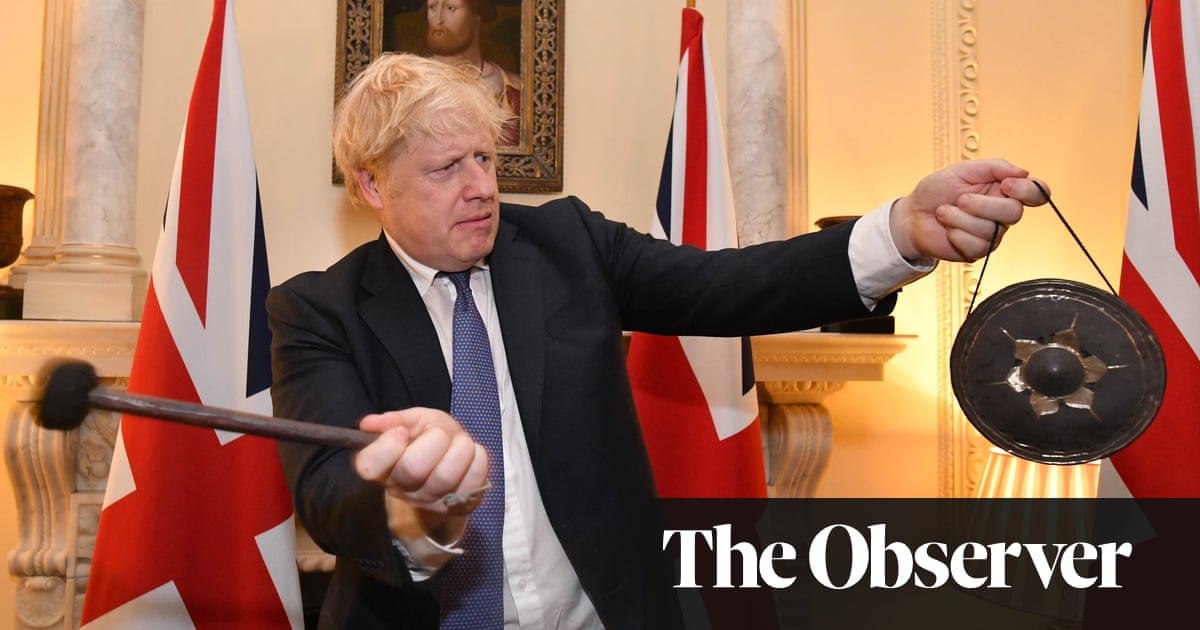Donald Trump may have been embarrassed by a picture from the White House lawn of his windswept hair and orange tan line, but Boris Johnson has few fears that similar moments will be captured behind the facade of 10 Downing Street.
Four bodies representing news photographers have accused No 10 of excluding them from events – the latest in a succession of complaints that Johnson’s government is attempting to mimic Trump’s attacks on the media and reduce press scrutiny.
No independent photographers were allowed to witness Johnson signing the EU withdrawal agreement, or the moment the UK left the EU on 31 January, when the prime minister banged a ceremonial gong.
Usually these events are covered by two rota photographers from regional or national newspapers or newswires. But the only images from Downing Street were taken by Johnson’s official photographer, Andrew Parsons.
The UK Picture Editors’ Guild, which represents national and regional newspapers and news agencies, and the News Media Association, which operates the rota for newspapers, have both complained, without any response.
Alan Sparrow, the guild’s chairman, said: “If the prime minister was to visit Saudi Arabia, or the Falklands, or go to Yorkshire after the floods, will we just be issued with pictures after the event? Pictures selected to present the government in the best possible light, not candid or journalistic. They’re just handout pictures, a bit like North Korea and the pictures issued by their leaders.
“Remember what happened with Gordon Brown and the ‘bigoted woman’ comment. Neil Kinnock falling over on the beach – had that been a coordinated event would we have seen it?”
Earlier this month political journalists walked out of Downing Street after officials attempted to exclude some of them from a briefing about trade negotiations. The Daily Mirror was also excluded from the Conservative battlebus during the election campaign.
No 10 has also been attempting to bypass broadcasters. After the general election campaign, ministers were told to boycott BBC Radio 4’s Today programme, ITV’s Good Morning Britain and Channel 4 News. Instead Johnson has made video statements via Facebook, including an address on 31 January.
The News Media Association said it was “deeply concerned by recent moves to exclude journalists and photographers from covering high-profile events and attending briefings in 10 Downing Street”. A spokeswoman added: “We urge No 10 to open a dialogue with the industry as soon as possible in order to resolve these issues.”
Lindsey Parnaby, chair of the British Press Photographers’ Association, said: “No one has any problem with Downing Street having their own photographer, but the media are impartial observers, so taking away that impartiality is never a good thing.”
Michelle Stanistreet, general secretary of the National Union of Journalists, said: “Boris’s gong also appears to have ushered in a new era of hostility towards working journalists trying their best to hold politicians and public figures to account. The petty mind games aimed at excluding journalists and media outlets who don’t meet with his or his advisers’ approval ill befits a prime minister and has to stop.”
Downing Street has continued to operate the photographers pool for some events, including the first meeting of Johnson’s new cabinet last week. A Downing Street source said: “The PM’s new images adviser will give greater insight into the workings of government in an open and transparent way.”
It is understood the pool will continue to be used, but No 10 made no commitment about whether that will include significant events.
Parsons, an award-winning photojournalist and war photographer who is popular among his colleagues, was appointed as a special adviser to the prime minister in January, a role dubbed “court photographer” by some. He was given a similar role by David Cameron in 2010, but was let go after criticism that his salary was paid for by taxpayers.
The concept of the official photographer is relatively new in British politics, although our leaders have attempted to portray themselves in the best light ever since Hans Holbein painted Henry VIII.
Tom Stoddart, who documented Tony Blair’s 1997 general election campaign from behind the scenes, said that trying to control the media would end badly for Johnson. “I was shooting in black and white – I wasn’t trying to compete with the newspaper photographers who were shooting in colour and I wasn’t distributing on the day,” he said.
“We don’t really have the tradition of access like they do in the White House, but the photographer who took that picture of Trump, William Moon, still has access to the White House.”
Tom Allbeson, a lecturer in cultural history at Cardiff University, said the first White House photographer was Cecil Stoughton, appointed by John F Kennedy. “This sort of image-making is possibly as old as the medium itself,” he said.
Carefully choreographed photo opportunities are not really historical events, he said, but “another small tweak to an already compromised interaction between politicians and the press”.
“The question isn’t so much the presence of the official photographer, then, but the exclusion of other press photographers. That’s what marks this out as something different. What if press photographers are excluded from state visits or conflict zones as happened, for instance, with the heavily managed approach to photography during the Falklands war?
“This move by No 10 is a valid source of anxiety. It might not be a radical departure from the norm in either historical or qualitative terms, but it could represent the thin end of a wedge.”
